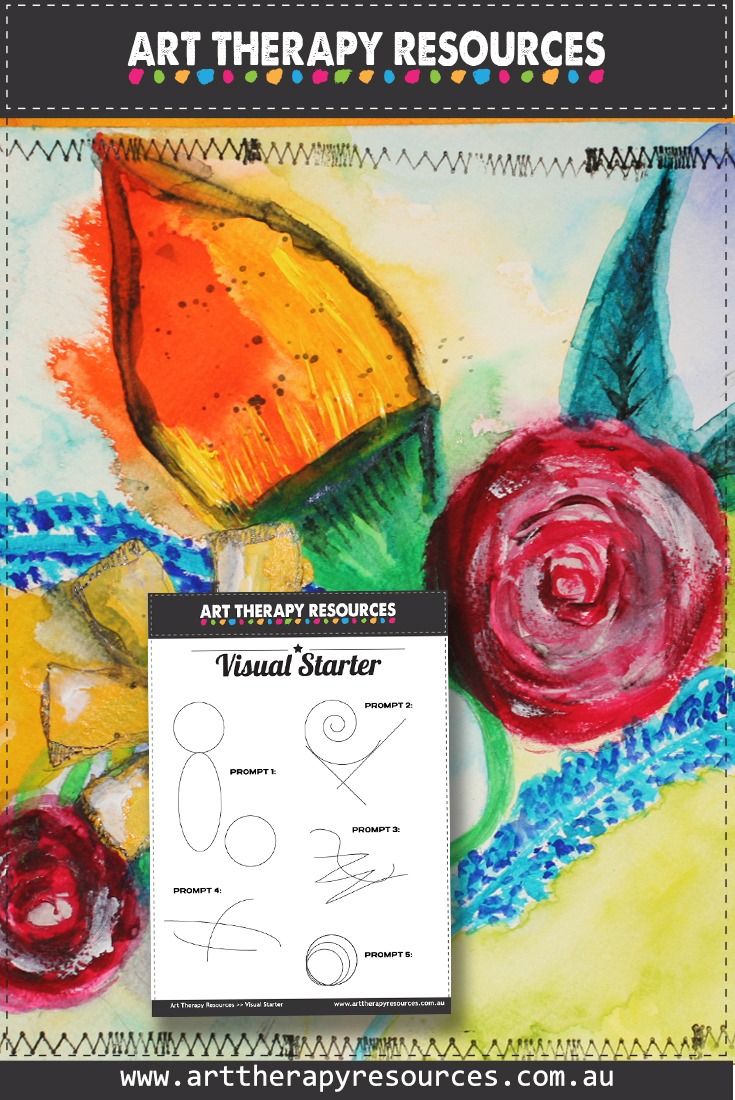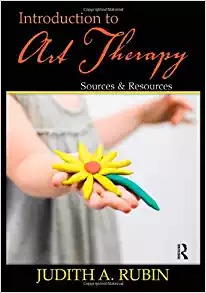THIS POST INCLUDES:
1. Introduction to Art Therapy: Sources & Resources
2. A review
3. Art Therapy Exercise
4. FREE Downloadable Visual Starters
Introduction to Art Therapy: Sources & Resources
Author: Judith A. Rubin
Date published: 2009, 2nd Edition
Page length: 366
Contents: 12 chapters in total. DOWNLOAD TABLE OF CONTENTS
Amazon purchase link: Introduction to Art Therapy: Sources & Resources
Goodreads link: Introduction to Art Therapy: Sources & Resources
ABOUT THE BOOK
Introduction to Art Therapy: Sources and Resources, is the thoroughly updated and revised second edition of Judith Rubin’s landmark 1999 text, the first to describe the history of art in both assessment and therapy, and to clarify the differences between artists or teachers who provide “therapeutic” art activities, psychologists or social workers who request drawings, and those who are trained as art therapists to do a kind of work which is similar, but qualitatively different.
This new edition contains a DVD-ROM with over 400 still images and 250 edited video clips for much richer illustration than is possible with figures alone; an additional chapter describing the work that art therapists do; and new material on education with updated information on standards, ethics, and informing others.
To further make the information accessible to practitioners, students, and teachers, the author has included a section on treatment planning and evaluation, an updated list of resources – selected professional associations and proceedings – references, expanded citations, and clinical vignettes and illustrations.
Three key chapters describe and expand the work that art therapists do: “People We Help,” deals with all ages; “Problems We Treat,” focuses on different disorders and disabilities; and “Places We Practice,” reflects the expansion of art therapy beyond its original home in psychiatry. The author’s own introduction to the therapeutic power of art – as a person, a worker, and a parent – will resonate with both experienced and novice readers alike. Most importantly, however, this book provides a definition of art therapy that contains its history, diversity, challenges, and accomplishments.
Book Content:
1 Previews
2 What Is Art Therapy?
3 History
4 The Basics
5 Approaches
6 Assessment
7 Technique(s)
8 People We Serve
9 Problems We Address
10 Places We Practice
11 Professional Issues
12 What Next?
I have included a pdf download of the chapters included in the book. You can also view the contents and a few sample chapters of the book on Amazon here.
A REVIEW OF INTRODUCTION TO ART THERAPY
Introduction to Art Therapy: Sources & Resources provides an excellent introduction to Art Therapy by providing an extensive overview of what art therapy is, along with the historical perspectives of art therapy. The book also provides a foundation of the basics of art therapy which includes the process of the creative process as well as the process of pathology and treatment planning. The book also covers important scientific principles by discussing qualitative and quantitative evidence as well as discussing the complications of establishing and robust art therapy research methods in order to improve the development of art therapy as a useful therapy intervention.
The most common therapy approaches used outside in non-art therapy practices are usually CBT, beahvioural modification and psychodynamic approaches that focus on unconscious processes. Therapies that focus on unconscious processes are often favoured by Art Therapists because creating art facilitates exploring unconscious conflicts that have been repressed.
In Introduction to Art Therapy, Rubin explores the wide range of approaches utilised by art therapists, including:
PSYCHODYNAMIC APPROACHES
- Freudian Psychoanalysis – emphasis on insight, sublimation and defense mechanisms
- Jungian Analytic Therapy – emphasis on symbolism and imagery, archetypes
HUMANISTIC APPROACHES
- Person-Centered Approach – emphasis on the powerful effect of empathy and positive regard for the client
- Adlerian – emphasis on the individual’s efforts towards success, connection with others, and contributions to society
- Gestalt – emphasis on personal responsibility, the individual’s experience in the moment, as well as the social environment of the person’s life
- Ericksonian – emphasis on psychosocial influences and defined the 8 stages of psychosocial development
- Phenomenological – emphasis on the individual’s experience in each moment of time
- Existential – emphasis on the inner conflict within a person being attributed to the individual’s perception of meaning within their existence.
PSYCHO-EDUCATIONAL APPROACHES
- Behavioral – emphasis on measurable behaviour and how learning occurs
- Cognitive – emphasis on thought processes in relation to maladaptive feelings and behaviours
- Developmental – emphasis on human development from childhood to adulthood
- Adaptive – emphasis on achieving specific goals that leads to adaptive functioning
OTHER APPROACHES
- Family Art Therapy
- Group Art Therapy
- Art/Image-Based Approaches to Art Therapy
- Spiritual Approaches to Art Therapy
- Integrative Approaches to Art Therapy
The book discusses the therapeutic approaches above in context of how they are used in art therapy which I think emphasizes how adaptable art therapy can be for treatment.
I purchased the Kindle version and did not receive a copy of the DVD that the book refers to. I researched this issue and found some readers who have the DVD noting that the DVD didn’t provide any substantial content outside of the book and that the book was the most useful aspect.
The book is very comprehensive and covers topics all the way from the history of art therapy to treatment and finally to professional issues and the future of art therapy.
Because of the extremely broad range of topics in the book, it does mean that the focus is sometimes on the quantity of topics covered instead of providing a more indepth coverage of a topic.
Given the book is titled: Introduction to Art Therapy, the level of depth into each topic was no doubt by design. The book is a good broad overview of the field of art therapy.
ART THERAPY EXERCISE

We have included an example exercise from the book. This exercise is featured in chapter 7, Techniques.
The task details are taken from the Introduction to Art Therapy: Sources & Resources . The supplies list and artwork image are provided by Art Therapy Resources. The visual starter prompts are created by Art Therapy Resources.
TASK: Visual starter: Use the download provided as a stimulus to create an artwork. A number of prompts are provided in the download. You can use each prompt to create various individual artworks or use all of the prompts for a larger artwork.
SUPPLIES: (Amazon affiliate links)
Dylusions Paint Tangerine Dream
Dylusions Paint Lemon Zest
Dylusions Paint Pure Sunshine
Dylusions Calypso Teal
Dylusions Pomegranate Seed
Dylusions Paint Cherry Pie
Dylusions Paint After Midnight
Dylusions Paint Chopped Pesto
Dylusions Paint Vibrant Turquoise
Golden Paints Heavy Body Light Green
Golden Paints Heavy Body Permanent Green Light
Golden Paints Heavy Body Turquoise Pthlalo
Golden Paints Fluid Diarylide Yellow
Liquitex White Gesso
Black Stabilo Pencil
Black Jelly Roll Pen
Stabilo Pencil Graphite
Versafine Black Ink Pad
Tim Holtz Wood Mounted Stamp Stitch
Simply Simmons Brushes
XL Watercolour Pad (trimmed to 12×12 inch)
Water Bottle
Pencil
Eraser
OUTCOME: Developing the client’s creativity by using images as a visual stimulus for the client.
Purchase: If this book sounds interesting to you, it can be purchased from Amazon. You can also view the contents pages and a few of the introductory chapters in the sample.
ART THERAPY EXERCISE – VISUAL STARTER ELEMENTS
SIGN UP below to download the FREE Visual Starter Elements.

BUILD YOUR ART THERAPY REFERENCE MATERIALS:
Pin this image to your Pinterest board.

SHARE KNOWLEDGE & PASS IT ON:
If you’ve enjoyed this post, please share it on Facebook, Twitter, Pinterest. Thank you!

